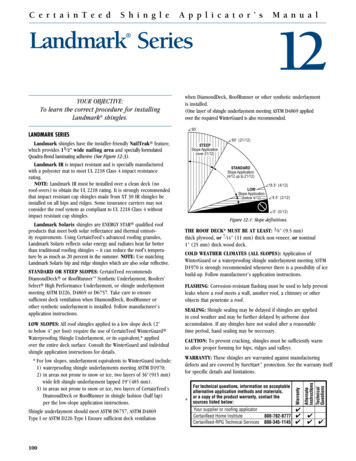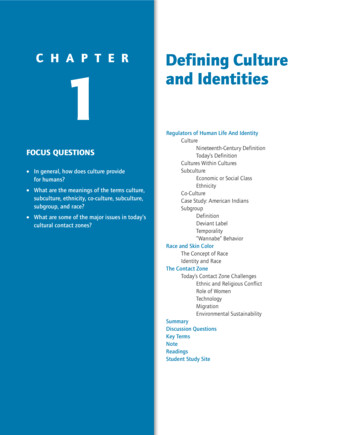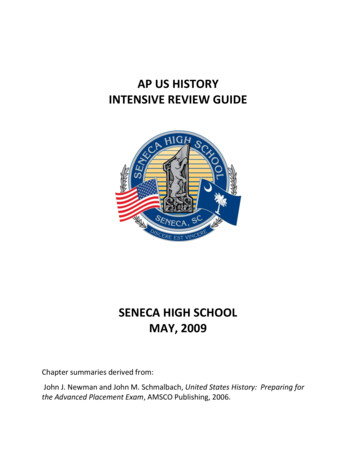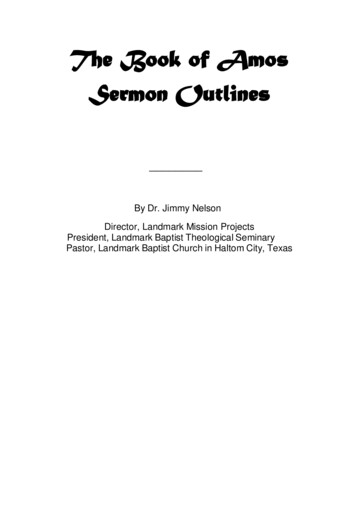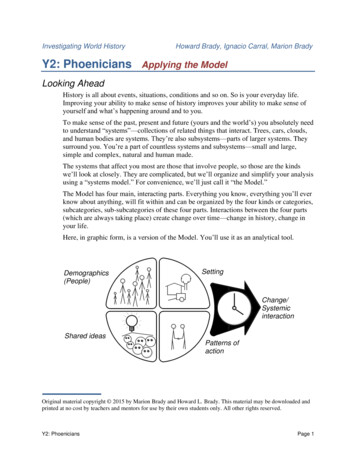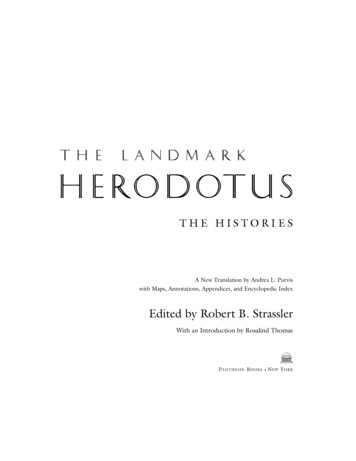
Transcription
Stra 9780375421099 3p fm r4.qxpT H E10/21/0812:32 PMPage iiiL A N D M A R KH E RO D OT U STHE HISTORI ESA New Translation by Andrea L. Purviswith Maps, Annotations, Appendices, and Encyclopedic IndexEdited by Robert B. StrasslerWith an Introduction by Rosalind ThomasPA N T H E O N B O O K S N E W YO R K
HdtFM-i-lxiv Repro8/31/074:12 PMPage ivCopyright 2007 by Robert B. StrasslerAll rights reserved. Published in the United States by Pantheon Books, a division of RandomHouse, Inc., New York, and in Canada by Random House of Canada Limited, Toronto.Pantheon Books and colophon are registered trademarks of Random House, Inc.Library of Congress Cataloging-in-Publication DataHerodotus.[History. English]The landmark Herodotus : the histories / edited by Robert B. Strassler ; translated by Andrea L.Purvis.p. cm.Includes bibliographical references and index.ISBN 978–0–375–42109–91. History, Ancient. 2. Greece—History—To 146 B.C. I. Strassler, Robert B., 1937–II. Purvis, Andrea L. III. Title.D58.H4713 2007 930—dc22 2007024149Designed by Kim LlewellynMaps by Topaz Maps, Inc.Index by Margot LevyPhoto research by Ingrid MacGilliswww.pantheonbooks.comPrinted in the United States of AmericaFirst Edition987654321
HdtFM-i-lxiv Repro8/31/074:12 PMPage viiCONTE NTSIntroduction by Rosalind ThomasEditor’s Preface by Robert B. StrasslerTranslator’s Preface by Andrea L. PurvisDated Outline of TextKey to MapsixxxxviixlixlilxivBOOK ONE1BOOK TWO115BOOK THREE205BOOK FOUR279BOOK FIVE365BOOK SIX425BOOK SEVEN491BOOK EIGHT599BOOK NINE663Appendix AAppendix BAppendix CAppendix DAppendix EAppendix FThe Athenian Government in HerodotusPeter Krentz, Davidson College723The Spartan State in War and PeacePaul Cartledge, University of Cambridge728The Account of Egypt: Herodotus Right and WrongAlan B. Lloyd, University of Wales737Herodotean GeographyJames Romm, Bard College744Herodotus and the Black Sea RegionEverett L. Wheeler, Duke University748Rivers and Peoples of ScythiaEverett L. Wheeler, Duke University756
HdtFM-i-lxiv Repro8/31/074:12 PMPage viiiCONTENTSAppendix GAppendix HAppendix IAppendix JAppendix KAppendix LAppendix MAppendix NAppendix OAppendix PAppendix QAppendix RAppendix SAppendix TAppendix UThe Continuity of Steppe CultureEverett L. Wheeler, Duke University759The Ionian RevoltGeorge L. Cawkwell, University College, Oxford762Classical Greek Religious FestivalsGregory Crane, Tufts University769Ancient Greek Units of Currency, Weight, and DistanceThomas R. Martin, College of the Holy Cross773Dialect and Ethnic Groups in HerodotusWilliam F. Wyatt, Brown University781Aristocratic Families in HerodotusCarolyn Higbie, State University of New York, Buffalo786Herodotus on Persia and the Persian EmpireChristopher Tuplin, University of Liverpool792Hoplite Warfare in HerodotusJ. W. I. Lee, University of California, Santa Barbara798The Persian Army in HerodotusJ. W. I. Lee, University of California, Santa Barbara805Oracles, Religion, and Politics in HerodotusDonald Lateiner, Ohio Wesleyan University810Herodotus and the PoetsAndrew Ford, Princeton University816The Size of Xerxes’ Expeditionary ForceMichael A. Flower, Princeton University819Trireme Warfare in HerodotusNicolle Hirschfeld, Trinity University824Tyranny in HerodotusCarolyn Dewald, Bard College835On Women and Marriage in HerodotusCarolyn Dewald, Bard College838GlossaryAncient SourcesBibliography for the General ReaderFigure CreditsIndexReference Mapsviii843846848850851951
HdtFM-i-lxiv Repro8/31/074:12 PMPage ixI N T RO D U C T I O NRosalind Thomas1. Opening Remarks§1.1. Herodotus’ Histories trace the conflict between the Greeks and the Persianswhich culminated in the Persian Wars in the great battles of Thermopylae, Salamis,Plataea, and Mycale (480–479),a a generation or so before he was writing. Hedescribed his theme as comprising both the achievements of Greeks and barbarians,and also the reasons why they came into conflict (Book 1, Proem). This suggeststhat he sought the causes of the conflict in factors that took one back deep into thepast and into the characteristics of each society. He implies that he saw the deepseated causes in cultural antagonism of Greek and non-Greek, but he went out ofhis way to describe the achievements and customs of many non-Greek peoples withastonishing sensitivity and lack of prejudice. The Histories are the first work in theWestern tradition that are recognizably a work of history to our eyes, for they coverthe recent human past (as opposed to a concentration on myths and legends), theysearch for causes, and they are critical of different accounts. Herodotus’ owndescription of them as an inquiry, a “historie ,” has given us our word “history,” andhe has been acknowledged as the “father of history.” He also has a claim to be thefirst to write a major work on geography and ethnography. His interests wereomnivorous, from natural history to anthropology, from early legend to the eventsof the recent past: he was interested in the nature of the Greek defense against thePersians, or the nature of Greek liberty, as well as in stranger and more exotic talesabout gold-digging ants or other wondrous animals in the East. The Histories arethe first long work in prose (rather than verse) which might rival the Homeric epicsin scale of conception and length. Shorter works in prose had appeared before, butthe Histories must in their time have been revolutionary.§1.2. Who, then, was Herodotus? As with most ancient Greek authors, we havelittle reliable information, and the later ancient biographers may have inventedbiographical “facts” by drawing from the content of the Histories themselves, as wascommon in ancient biographies of writers. He was born in Halicarnassus a in AsiaMinor,b now modern Bodrum in western Turkey. He spent much of his life in exile,Intro.1.1a All dates in this edition of Herodotus and inits supporting materials are B.C.E. (Before theCommon Era), unless otherwise specified.Intro.1.2a Halicarnassus: Map Intro.1.Intro.1.2b Asia Minor (Asia): Map Intro.1, locator.ix
HdtFM-i-lxiv Repro8/31/074:12 PMPage xINTRODUCTIONspending some time in Samos,c some in Athens,d and apparently ending up in Thurii,ethe Athenian Panhellenic colony founded in south Italy (Aristotle in the fourthcentury knew him as Herodotus of Thurii). The Histories themselves provide theevidence for his extensive travels in the Greek world, Asia Minor, Phoenicia, Egypt andNorth Africa,f and perhaps the Black Sea g (see below). Unlike in many modern travelogues, the main focus of interest is not on the traveling itself but on the informationit yields, so again the personal elements are not extensive. His life spanned much ofthe fifth century: here there is no reason to doubt the ancient tradition that he wasborn at roughly the time of the Persian Wars (480–479), and he probably lived intothe 420s, since the Histories make references to events in Greece early in the Peloponnesian War of 431–404. It is usually thought that he was active as researcher andwriter from the 450s to the 420s. The Histories clearly constituted a life’s work.2. The Historical Background§2.1. The beginning of this period saw the triumph of the Greek mainland statesover the might of the Persian Empire, first in the initial invasion of 490 and the battleof Marathon,a then in the second invasion of 480/79, with the battles of Thermopylae,Salamis, Plataea, and finally Mycaleb in Asia Minor. This unexpected victory resonatedin Greek consciousness through the fifth century and indeed beyond, and it is important to recall this when reading Herodotus, who was researching a generation or twoafter the Greek victory. It helped crystallize Greeks’ attitudes to their own way of lifeand values, intensified their supreme distrust of monarchy and tyranny, and shapedtheir attitude to the Persians. In more practical terms, Athens’ naval success in thePersian Wars and its enterprise immediately after led to the creation of the AthenianEmpire, which started as an anti-Persian league and lasted for almost three-quarters of acentury (479–404). As the Spartansc were increasingly reluctant to continue antiPersian activity into the Hellespont and Asia Minor, the Athenians were free to createtheir maritime league composed of many smaller Greek states situated around theAegean and up into the Hellespont.d Athenian power grew steadily and Athens eventried a disastrous expedition to help Egypt rebel against the Persian King. As her radicaldemocracy developed from the 460s, conflict arose between her and the other powerful Greek states, particularly Corinth e and Sparta and the members of Sparta’s Peloponnesian League. By the late 430s tensions had reached their height. War broke out in431 between Athens and her allies and Sparta and hers. Athens was now a “tyrant city,”the Corinthians claimed (Thucydides 1.122.3; generally, 1.68–71, 1.120–124), andGreece must now be freed from Athens. Greece had been freed from the Persiansf onlyto be enslaved by Athens. The great historian of this later war, Thucydides, was successor and rival to Herodotus. As he makes his Athenian speakers remark in the openingbook of his history, they are weary of pointing out that the Athenian Empire is amos: Map Intro.1.Athens: Map Intro.1.Thurii: Map Intro.1, locator.Phoenicia, Egypt, and North Africa (Libya):Map Intro.2.Intro.1.2g Euxine (Black) Sea: Map Intro.1, locator.Intro.2.1a Marathon: Map Intro.1.xIntro.2.1b Battle sites of 480: Thermopylae and Salamis,of 479, Plataea and Mycale: Map Intro.1.Intro.2.1c Sparta: Map Intro.1.Intro.2.1d Aegean Sea: Map Intro.1. Hellespont: MapIntro.1, locator.Intro.2.1e Corinth: Map Intro.1.Intro.2.1f Persia: Map Intro.2.
HdtFM-i-lxiv Repro8/31/074:12 PMPage liDAT E D O U T L I N E O F T E XTBook 1Proem, 1.11.2–5Herodotus identifies himself, describes his subject, and stateshis purpose in writing the Histories.450–420?ASIA-GREECEAbductions of various Greek and Asian women.1.6–29LYDIAHISTORIES BEGIN: CROESUS OF LYDIA1.7–12LYDIAGyges kills Kandaules and becomes king of Lydia.1.13–14LYDIAGyges is confirmed by Delphic oracle; his reign.716–6781.15LYDIAArdys’ reign; captures Priene, invades Miletus, Cimmerians.678–6291.16–17LYDIASadyattes’ reign; drives out Cimmerians, takes Smyrna.629–6171.18–22LYDIA-MILETUSAlyattes’ reign; makes peace with Miletus.617–5601.23CORINTHPeriandros (r. 627–587) informs Thrasyboulos of the oracle.1.24TARAS-CORINTHThe tale of Arion.1.25LYDIA-DELPHIAlyattes’ gifts to Delphi.LYDIACROESUS’ REIGN: CONQUERS GREEKS IN ASIA;DEFEATED BY CYRUS1.26–921.29–33LYDIACroesus and Solon.1.34–45LYDIAThe story of Adrastus; death of Atys, Croesus’ son.1.46–56LYDIACroesus decides to attack Persia, tests oracles, rewards 60–547/46550–?Herodotus speculates on language of the Pelasgians.ATHENSPeisistratos’ rise to tyrannical power at Athens. (r. c. 561–556, 555?–?, 546–528)1.65SPARTALykourgos reforms and establishes the Spartan government.1.66–68SPARTASpartan conflict with Tegea.1.69–70SPARTASpartans agree to assist Croesus.1.71–1.73CAPPADOCIALydians cross the Halys River into Persian-controlled territory.1.74–75CAPPADOCIAThales predicts eclipse (585); diverts Halys River (547?).548–547547?li
HdtFM-i-lxiv Repro8/31/074:12 PMPage lxivKey to MapsMap ConfigurationsTypographyLocator mapAS I AAEOLISMain mapHeliopolisAthensKadousiansInset mapHalys R.MT. OLYMPUSCultural FeaturesSettlementsDemeContinents; regionsLarge cities; other locationsPeoples and tribesBodies of water; islands; promontoriesMountainsNatural FeaturesMountain; mountain rangeCliff or escarpmentFortified placeTempleBattle siteRiverMarshRoadCity walls and fortificationsSeas and lakes(approximate extent in Classical Period)Distance ConversionsWherever possible and appropriate, I have converted Herodotus’ original units of distance(stades, plethra, cubits, etc.) into miles and feet, and noted in a footnote the original unitsthat are cited in the text. In calculating modern units, unless the text specifies other units, Ihave assumed the use of the Attic stade of 583 feet and the more or less standard cubit of oneand a half feet. The reader should realize, however, that different “standard” stade and cubitunits were in use in the ancient Mediterranean world, and Herodotus might have had one ofthem in mind when he gave his measurements, so that we can never know the actual lengthswith any precision. See Appendix J, Units of Currency, Weight, and Distance.DatesAll dates in this volume and in its supporting materials are B.C.E. (Before the Common Era),unless otherwise specified.lxiv
Hdt Bk2 115-204 3rdPass8/29/074:48 PMPage 115BOOK TWO
Hdt Bk2 115-204 3rdPass8/29/074:48 PMPage 117When Cyrus died, the kingship wasinherited by Cambyses. He was the son of Cyrus by Cassandane daughterof Pharnaspes. Cassandane had died before Cyrus, and he had grieved forher with great sorrow and ordered all of his subjects to grieve for her, too.[2] As the son of this woman and Cyrus, Cambyses considered the Ioniansaand Aeoliansb as his slaves whom he had inherited from his father, and whenhe made his expedition to Egypt,c he took with him these Hellenes whowere under his rule, along with the rest of his subjects.Now, before Psammetichos became king, the Egyptians used to believethat they were the earliest humans. But upon assuming the kingship, Psammetichos became eager to ascertain which people were really the first; andever since his reign, the Egyptians consider that the Phrygiansb lived beforethey did, but that they themselves existed prior to all the rest of humanity.[2] Unable to find a means of discovering who were the first humans bymaking inquiries, Psammetichos devised an experiment. He selected twonewborn children from ordinary people and gave them to a shepherd totake into his flocks and raise according to the following instructions: no onewas to utter a word in their presence; the shepherd should place them in asecluded hut by themselves and at appropriate intervals bring in the goats,give the children their fill of milk, and then tend to the rest of their needs.[3] The reason he gave these instructions was because he wished to listen tothe children after they had outgrown their inarticulate crying and to findout what word they would speak first. And everything turned out as heplanned, for the shepherd had followed his orders for two years when oneday, as he opened the door and entered, both children rushed at him withoutstretched hands, crying out “bekos.” [4] At first the shepherd kept quietabout having heard this, but when the word bekos was repeated again andagain as he came and went in his care for the children, he told his master. Athis command the shepherd brought the children into his presence, and2.1.2a2.1.2b2.1.2cIonia: Map 1.204, inset.Aeolis: Map 1.204, inset.Egypt: Map 1.204. See Appendix C, The2.2.1b2.1530Cambyses succeeds Cyrusand prepares to attack Egypt.2.2EGYPTPsammetichos (r. 664–610)of Egypt determines byexperiment that Phrygianswere the earliest peopleon earth.Account of Egypt: Herodotus Right andWrong, §1.Phrygia: Map 1.204.117
Hdt Bk2 115-204 3rdPass8/29/074:48 PMHerodotus’ Egyptian sources2.3EGYPTHerodotus lists some of hisEgyptian sources.2.4EGYPTThe Egyptian calendar issuperior to the Greek.Herodotus is told that thefirst ruler of all Egypt is Min,who is thought to havereigned c. 3000.2.5EGYPTEgypt consists of muddeposited by the Nile River.EGYPTBOOK TWOPsammetichos himself heard the word. When he inquired which peoplemight use the word bekos, he discovered that the word bekos means “bread”in the Phrygian language. [5] Thus the Egyptians accepted this evidence andconcluded that the Phrygians are older than themselves. I heard this accountfrom the priests of Hephaistos at Memphis.a Hellenes tell many different sillystories—for example, there is one that Psammetichos cut out the tongues ofsome women and made the children live with them.Such are the stories told about how the children were raised. But I heardother things in Memphis, too, when I conversed with the priests of Hephaistos. And I also went to Thebes a and Heliopolis,b since I wanted to see if theyagreed with what was said in Memphis. For of all the Egyptians, theHeliopolitans are said to be the most learned in tradition. [2] I have no desireto relate what I heard about matters concerning the gods, other than theirnames alone, since I believe that all people understand these things equally.But when my discussion forces me to mention these things, I shall do so.As to all matters concerning the human world, they were in agreement.They said that the Egyptians were the first of all peoples to discover theyear, by dividing up the seasons into twelve parts to total one year, and thatthey discovered how to do this from the stars. The Egyptians seem to me tobe much wiser than the Hellenes in the way they regulate the timing of theseasons. While the Hellenes attempt to preserve the timing of the seasonsby inserting an intercalary month every other year, the Egyptians divide theyear into twelve months of thirty days each and add just five days each yearbeyond that number, and thus their seasons do return at the same periodsin the cycle from year to year.[2] They said that the Egyptians were also the first to establish the tradition of identifying namesa for the twelve gods, and that the Hellenes adoptedthis practice from them. They were also the first to assign altars, statues, andtemples to the gods and to carve their figures in relief on stone. The priestsin fact demonstrated with proofs that these claims were valid, but they couldonly assert that the first man to be king of Egypt was Min.b [3] During hisreign, they said, all Egypt was swamp except for the district of Thebes, andnone of it protruded above water beyond what is now the lake of Moeris,awhich lies at a seven-day voyage upriver from the sea.It seemed to me that they accurately described the nature of their land.For even if one has not heard about it in advance, it is obvious to anyonewith common sense when he sees it for himself: the Egypt to which theHellenes sail is land that was deposited by the river—it is the gift of the riverto the Egyptians, as is also the area south of the lake as far as a three-dayvoyage upriver. Although they said nothing further about this, there is2.2.5a2.3.1a2.3.1b2.4.2a118Page 118Memphis: Map 2.6, Egypt inset.Thebes, Egypt: Map 2.6, Egypt inset.Heliopolis: Map 2.6, Egypt inset. Thename means City of the Sun; in Egyptian, the House/Abode of Ra/Re.Herodotus uses a word which literallymeans “epithet” here. He probably2.4.2b2.4.3ameans that the Egyptians were the first touse specific and particular names for eachdivinity in contrast to theoi/gods—a collective designation.Min is Menes. See 2.99.Lake Moeris: Map 2.6, Egypt inset.
Hdt Bk2 115-204 3rdPass8/29/074:48 PMPage 119BOOK TWOEGYPTsomething more to add; [2] the nature of Egypt is such that if you are in aboat one whole day’s sail distant from the land and you let down a sounding line, you will bring up mud even to the depth of eleven fathoms.a Thisshows just how far the alluvial deposit of the land extends.The length of the Egyptian seacoast, as we Hellenes define the territory ofEgypt, is 60 schoinoi,a from the Gulf of Plinthine b to Lake Serbonis,c alongwhich extends Mount Casius.d It is from this place that the 397 miles are measured. [2] Whoever possesses very little property here measures his land infathoms; those who have somewhat more, in stades; those who have much, inparasangs; and those who have an extremely sizeable portion, in schoinoi. [3]A parasang is equal to thirty stades; each schoinos, an Egyptian unit of measure, is equal to sixty stades.a Thus the coast of Egypt is 397 miles in length.bFrom the coast, Egypt extends inland as far as Heliopolis in a broadexpanse, entirely flat, wet, and muddy. The road from the sea to Heliopolis isabout as long as the road leading from the Altar of the Twelve Gods atAthens a to the temple of Olympian Zeus in Pisa.b [2] If one measured thelength of both these roads, one would discover that they are not exactly equalin length, but that the difference between them is negligible, no more thanone and a half miles by which the road from Athens to Pisa is shorter than the165 miles a which is the full length of the road from the sea to Heliopolis.From Heliopolis, Egypt becomes narrow as one travels farther inland.For on one side, toward Arabia,a there extends a mountain range fromnorth to south, and toward the south it winds all the way to the sea calledErythraean.b In these mountains are the stone quarries from which thestones for the pyramids near Memphis were cut. The mountain range ends2.5.2a2.6.1a2.6.1b2.6.1c2.6.1d2.6.3aThe fathom 6 feet. See Distance Conversions, p. lxiv, and Appendix J, AncientGreek Units of Currency, Weight, andDistance, §4, 5, 19. Herodotus’measurement is wrong; a depth of 11fathoms is encountered much nearer thecoast of Egypt than a full day’s sail.Herodotus’ “60 schoinoi” comes toapproximately 397 miles. Schoinoi(skhoinoi): literally, “ropes,” were anEgyptian unit of measurement whoselength can vary. See Appendix J, §5–7, 19.Herodotus occasionally shows off hisknowledge of foreign terms and units ofmeasure.Plinthine Gulf: Map 2.6, Egypt inset.Lake Serbonis: Map 2.6, Egypt inset.Herodotus calls it the Serbonian Marsh in3.5.2.Mount Casius: Map 2.6, Egypt inset.The fathom 6 feet.The Attic stade 583 feet.The parasang (30 stades or .5 schoinos) 17,490 feet 3.3 miles.The schoinos (60 stades) 34,980 feet 6.6 miles.But Herodotus may have had differentunits in mind when he made his estimate.See Appendix J, §4–7, 19.2.6.3b2.7.1a2.7.1b2.7.2a2.8.1a2.8.1bLength of the coast of Egypt2.6EGYPTLength of the Egyptianseacoast.2.7EGYPTA description of thedimensions of Egypt.2.8NILE VALLEYMountains border both sidesof the narrow Nile valleyabove Heliopolis.If one schoinos 60 stades, then the “60schoinoi” of the coast of Egypt wouldequal 3,600 stades, or about 397 miles.This is a significant overestimate. Justunder 300 miles would be more accurate.Athens: Map 2.6, Aegean inset.Pisa (Olympia): Map 2.6, Aegean inset.Herodotus actually writes that the difference between the two distances (Athens toPisa and the Egyptian coast to Heliopolis)is negligible, that between Ayhens andPisa (Olympia) being barely one percentless than the 1,500 stades which he saysseparate the Egyptian coast from Heliopolis. The distances are not really equivalentat all. The 1,500 stades between theEgyptian coast and Heliopolis wouldcome to some 165 miles, whereas the thelength of the road from Athens to Pisa(Olympia) is closer to 110 miles. Ofcourse, the coast of Egypt has extended agood deal farther north into the sea todaythan it was in Herodotus’ day. See Appendix C, §3.Arabia: Map 2.6. The Arabian mountainsextend along the western bank of the Nile.Erythraean Sea, in this case the sea to theeast of the Nile, i.e., the modern Red Sea:Map 2.6 and Egypt inset.119
Hdt Bk2 115-204 3rdPass8/29/074:48 PMPage 120Mountains border both sides of the Nile valleyNILE VALLEYBOOK TWOE U RO P EAS I A A S S YRIASYRIMediterranean SeaAARABIAL I BYAErythraeanSeaEPIA2000 kmIONile R.TH02000 miMt. CasiusPlinthineGulfLakeSerbonisTroyAchelous risTeuthraniaE G YP TUPPER EGYPTAthensEphesusR.nderM a eaErythraeanSeai 00 km200 km200 mi200 miMAP 2.6here at the quarries and slopes down toward the Erythraean Sea. This is thebroadest part of the range, so I am told, requiring a two-month journeycfrom east to west, and at its eastern extremity the land produces frankincense. [2] Such is this mountain range, but there is another one on theLibyan side of Egypt where the pyramids are located, which is composed ofstone. It is coated with sand and it extends parallel to the Arabian mountainto the south. [3] From Heliopolis a to the south, the land area of Egypt isnot large but becomes a narrow strip which is so long that it requires a four2.8.1c120There is no place where it can be a twomonth journey from the Nile west acrossthis mountain range to the Red Sea.2.8.3aHeliopolis: Map 2.6, Egypt inset.
Hdt Append 723-842 3rdPass8/29/075:41 PMPage 723APPENDIX AThe Athenian Government in Herodotus§1. Attica, the triangular peninsula of ancient Athens, has a number of plains inaddition to the one around Athens itself: the Plain of Marathon beyond Mount Pentelikon to the northeast, the Plain of the Mesogaia beyond Mount Hymettos to the east,and the Thriasian Plain beyond Mount Aigaleos to the west.a These plains might havesupported numerous independent city-states (poleis) of a typical size. According toAthenian tradition, the legendary Bronze Age hero Theseus had united the twelvepoleis of Attica long ago, although many scholars today place the unification later,some as late as the end of the sixth century. Certainly Athens in the archaic periodplayed only a limited role on the broader Greek stage, struggling even to keep its neighbor Megarab from annexing the island of Salamis,c just off the west coast of Attica.§2. At the time of the Persian Wars, the Athenians had a democratic governmentin which every adult male citizen was entitled to vote in the Assembly. King Theseushimself was said to have made a “democratic” proclamation reducing the powers ofAthens’ traditional kings in some way, perhaps by recognizing certain families asEupatrid (“well-born”) and creating the Council of the Areiopagos as an advisorybody. But the man Athenians generally credited with creating their democracy wasSolon, archon in 594/93,a who was given extraordinary powers to write laws, notnecessarily in 594/93 but certainly within the first four decades of the sixth century.§3. Legend said that centuries before Solon, Eupatrid archons (leaders or magistrates) replaced the kings, at first archons ruling for life, later for ten-year terms, andfinally for a single year. The basileus (king), the polemarchos or polemarch (warleader), and the eponymous archon (who gave his name to the year) were the first tobe created. Later six thesmothetai (lawgivers) were also named annually, for a total ofnine archons, who became life members of the Council of the Areiopagos after theyleft office. The archons had the authority to give final judgments in legal disputes,and the Council of the Areiopagos supervised the city’s affairs.§4. Solon’s special appointment grew out of increasing tension between rich andpoor. Poor Athenians had fallen into debt, some being sold into slavery when theyA.1a Attica, Athens, Marathon Plain, Mount Pentelikon, Mesogaia Plain, Mount Hymettos, ThriasianPlain, Mount Aigaleos: Map A, inset.A.1b Megara: Map A, inset.A.1c Salamis: Map a, inset.A.2a Solon appears at 1.29–33. See n. 1.29.1a.723
Hdt GlosBibFig 843-850 Repro8/31/071:46 PMPage 843G L O S S A RYAchaimenids: royal family of Persian empire. Founded by Cyrus in 550.acropolis: the citadel or high point of a Greek city; often the site of the original settlement, and inhistoric times well stocked with temples and sacred sites, enclosed by its own set of defensive walls.Aeolians: an ethnic group of Greeks, inhabiting Aegean islands and the west coast of Asia Minornorth of Smyrna.aegis: Athena’s shield or short cloak, with a fringe of snakes and device of Medusa’s head.Agiads and Eurypontids: Spartan royal hereditary families, each one supplying one of the tworeigning kings of Sparta.agora: the agora was the civic center of a Greek polis where all political, commercial, and muchsocial activity took place. A fundamental feature of every Greek city, it was a marketplace where citizens could buy and sell goods, gossip, and discuss politics or other topics.akinakes: a type of Persian and Scythian sword. An akinakes was short and straight.Amphiktyonic League/Amphiktyones: a league made up of representatives from mostly neighboring states who were selected to maintain, protect, and defend the sanctuary of Delphi. They hadresponsibility for administering the sanctuary, and could impose fines, declare sacred wars, and awardcontracts for building projects.angareion: a system organized by the Persians of mounted couriers riding in relays to swiftly carryroyal messages.archon: a magistrate at Athens, chosen by lot in the later fifth century. The nine archons were concerned with administering justice, overseeing foreign residents of Athens, adjudicating family property disputes, and carrying out a variety of other tasks. The eponymous archon gave his name tothe civil year.Argonauts/Argo : the subject of an ancient Greek epic legend with common themes. To rid himselfof Jason, a dangerous pretender to the throne, King Pelias of Iolkoss in Thessaly, sends him far awayon a journey to bring back the Golden Fleece. Jason gathers a group of noble Minyans, togetherwith other heroes such as Herakles and Orpheus, and sails off in a ship built by the hero Argos, andcalled the Argo, to Colchis on the Black Sea, where the fleece is located. After many harrowingadventures they arrive at Colchis, where King Aeetes gives them further dangerous tasks to accomplish. With the help of Medea, the king’s daughter, they successfully complete the tasks and obtainthe Golden Fleece. Then, taking Medea with them, Jason and the Argonauts return to Greece.battos : a North African word for king.Bosporus: a narrow strait separating two lands —Thracian Bosporus separates Europe from Asia,the Cimmerian Bosporus separates the Crimea from Eastern Scythia.Council of Elders/the Gerousia: the senate and highest council of Sparta. The Council was madeup of thirty members over the age of sixty, although it included the two reigning kings of Sparta atany age. Members, who were limited to certain aristocratic families, were elected and served for li
the Corinthians claimed (Thucydides 1.122.3; generally, 1.68-71, 1.120-124), and Greece must now be freed from Athens. Greece had been freed from the Persiansf only to be enslaved by Athens. The great historian of this later war, Thucydides, was succes-sor and rival to Herodotus. As he makes his Athenian speakers remark in the opening
